Investigation of the Internal Flow in a Francis Turbine for Comparing the Flow Noise of Different Operation Conditions
Abstract
:1. Introduction
2. Research Object
3. Mathematical Methods
3.1. Basic Equations
3.2. Turbulence Model
3.3. Flow-Induced Noise Analysis
4. Setup of CFD
5. Comparison of Experimental and Numerical Results
6. Results of CFD
6.1. Streamlines
6.2. Flow-Induced Noise
6.2.1. Reference Planes for Plotting
6.2.2. Contours of Flow-Induced Noise
6.2.3. The Variation in Flow-Induced Noise with Flow Direction
7. Discussion
8. Conclusions
- (a)
- The main locations where flow-induced noise occurred included spiral case inlets, runner blade inlet edges, draft tube walls, and the middle of the draft tube. The flow-induced noise was closely related to the flow convergence and extrusion, fluid–blade interaction, draft tube rotating flow, etc. The noise caused by the interaction between the fluid and high-speed rotating runner was often the strongest;
- (b)
- Flow-induced noise was related to the operation condition. When the turbine was operating in the allowed region (point one), the noise was lower. When the turbine was operating in the restricted region (point two) and the prohibited region (point three), the noise was higher. An exception occurred in the region near the vanes, as it was mainly affected by the opening of the guide vanes;
- (c)
- The difference in sound power level was related to the flow regime. When swirling flow was strong, it could cause high noise. When flow was smooth, the induced noise was low. In addition, flow-induced noise was not significant when flow was obstructed. In contrast, when the flow passed through the guide vanes at high speed, the flow-induced noise was strong.
Author Contributions
Funding
Data Availability Statement
Acknowledgments
Conflicts of Interest
References
- Zheng, Y.; Chen, D.X. Hydraulic Turbine, 3rd ed.; China Water Resources and Hydropower Press: Beijing, China, 2008; pp. 219–247. [Google Scholar]
- Huang, J.F.; Wang, C.Y.; Wen, J.; Rao, B.Y.; Long, L.Y. Research on Vortex of a Francis Hydro-turbine Based on CFD Technology. J. Yunnan Agric. Univ. 2010, 25, 147–151. [Google Scholar]
- Wan, Y.; Tan, Z.G. Vibration characteristics test-based analysis and evaluation on stability of large francis turbine-generator unit. Water Conserv. Hydropower Technol. 2014, 45, 15–19. [Google Scholar]
- Chen, T.; Zhang, Y.N.; Li, S.C. Instability of large-scale prototype Francis turbines of Three Gorges power station at part load. Proc. Inst. Mech. Eng. 2016, 230, 619–632. [Google Scholar] [CrossRef]
- Liu, D.M.; Liu, X.B.; Zhao, Y.Z. Experimental Investigation of Inter-Blade Vortices in a Model Francis Turbine. Chin. J. Mech. Eng. 2017, 30, 854–865. [Google Scholar] [CrossRef]
- Liu, D.M.; Liu, X.B.; Zhang, H.K. Introduction the Original Reason of Channel Vortex Based on the Cavitation Model. In Proceedings of the 35th World Congress of the International-Association-for-Hydro-Environment-Engineering-and-Research (IAHR), Chengdu, China, 8–13 September 2013. [Google Scholar]
- Kamal, M.; Saini, G.; Abbas, A.; Prasad, V. Prediction and analysis of the cavitating performance of a Francis turbine under different loads. Energy Sources Part A-Recovery Util. Environ. Eff. 2021, 1–25. [Google Scholar] [CrossRef]
- Guo, T.; Xu, L.H.; Luo, Z.M. Influence of Upstream Disturbance on Vortex Rope Evolution and Pressure Fluctuation in Draft Tube. Trans. Chin. Soc. Agric. Mach. 2022, 53, 192–201. [Google Scholar]
- Frunzǎverde, D.; Muntean, S.; Mǎrginean, G.; Campian, V.; Marşavina, L.; Terzi, R.; Şerban, V. Failure analysis of a Francis turbine runner. In Proceedings of the 25th IAHR Symposium on Hydraulic Machinery and Systems, Timisoara, Romania, 20–24 September 2010. [Google Scholar]
- Wang, H.L.; Zheng, Y.; Sun, A.R.; Zhang, F.L.; Gao, C.H.; Zhou, Y. The influence of guide vane opening on pressure pulsation characteristics and flow-induced noise in Francis turbine. South-North Water Transf. Water Sci. Technol. 2019, 16, 186–192. [Google Scholar]
- Pang, L.J.; Zhong, S.; Bu, L.F.; Hu, J.W. Analysis of abnormal noise of francis turbine by scene test. J. Vib. Shock 2012, 31, 39–42. [Google Scholar]
- Liu, P.; Chen, X.L.; Wang, Q.; Li, D. Analysis of rotor-stator interaction and vibration in high-head Francis turbines. J. Hydroelectr. Eng. 2016, 35, 91–98. [Google Scholar]
- Kubo, K.; Nakashima, T.; Shima, R.; Enomoto, Y. CFD-based rehabilitation for the high specific speed Francis turbine. In Proceedings of the 29th IAHR Symposium on Hydraulic Machinery and Systems (IAHR), Kyoto, Japan, 16–21 September 2018. [Google Scholar]
- Luo, X.; Yu, A.; Yu, W.; Wang, L.; Xu, H. Pressure oscillation suppression by air admission in a Francis turbine draft tube. In Proceedings of the 29th IAHR Symposium on Hydraulic Machinery and Systems (IAHR), Kyoto, Japan, 16–21 September 2018. [Google Scholar]
- Wang, H.Z.; Zhou, D.Q.; Zhang, L.G. Numerical simulation of flow noise of low specific speed Francis turbine. Hydropower Energy Sci. 2014, 32, 153–156. [Google Scholar]
- Wang, W.; Chen, Q.; Yan, D.; Geng, D. A novel comprehensive evaluation method of the draft tube pressure pulsation of Francis turbine based on EEMD and information entropy. Mech. Syst. Signal Process. 2019, 116, 772–786. [Google Scholar] [CrossRef]
- Favrel, A.; Landry, C.; Müller, A.; Avellan, F. Experimental identification and study of hydraulic resonance test rig with Francis turbine operating at partial load. In IOP Conference Series: Earth and Environmental Science; IOP Publishing: Bristol, UK, 2012. [Google Scholar]
- Chen, D.Y.; Zhao, W.L.; Sprott, J.C.; Ma, X.Y. Application of Takagi-Sugeno fuzzy model to a class of chaotic synchronization and anti-synchronization. Nonlinear Dyn. 2013, 73, 1495–1505. [Google Scholar] [CrossRef]
- Xu, B.B.; Chen, D.Y.; Zhang, H.; Zhou, R. Dynamic analysis and modeling of a novel fractional-order hydro-turbine-generator unit. Nonlinear Dyn. 2015, 81, 1263–1274. [Google Scholar] [CrossRef]
- Xu, B.B.; Chen, D.Y.; Zhang, H.; Wang, F.F. Modeling and stability analysis of a fractional-order francis hydro-turbine governing system. Chaos Solitons Fractals 2015, 75, 50–61. [Google Scholar] [CrossRef]
- Xu, B.B.; Wang, F.F.; Chen, D.y.; Zhang, H. Hamiltonian modeling of multi-hydro-turbine governing systems with sharing common penstock and nonlinear dynamic analyses under shock load. Energy Convers. Manag. 2016, 108, 478–487. [Google Scholar] [CrossRef]
- Chen, M. Fundamentals of Viscous Fluid Dynamics; Higher Education Press: Beijing, China, 1993. [Google Scholar]
- Terentiev, L. The Turbulence Closure Model Based on Linear Anisotropy Invariant Analysis; VDM Verlag: Saarbrucken, Germany, 2008. [Google Scholar]
- Menter, F.R. Two-Equation Eddy-Viscosity Turbulence Models for Engineering Applications. AIAA J. 1994, 32, 1598–1605. [Google Scholar] [CrossRef]
- Proudman, I. The generation of noise by isotropic turbulence. Proc. R. Soc. A 1952, 214, 119–132. [Google Scholar]
- Celik, I.B.; Ghia, U.; Roache, P.J.; Freitas, C.J.; Coleman, H.; Raad, P.E. Procedure for Estimation and Reporting of Uncertainty due to Discretization in CFD Applications. J. Fluids Eng. Trans. ASME 2008, 130, 078001. [Google Scholar]

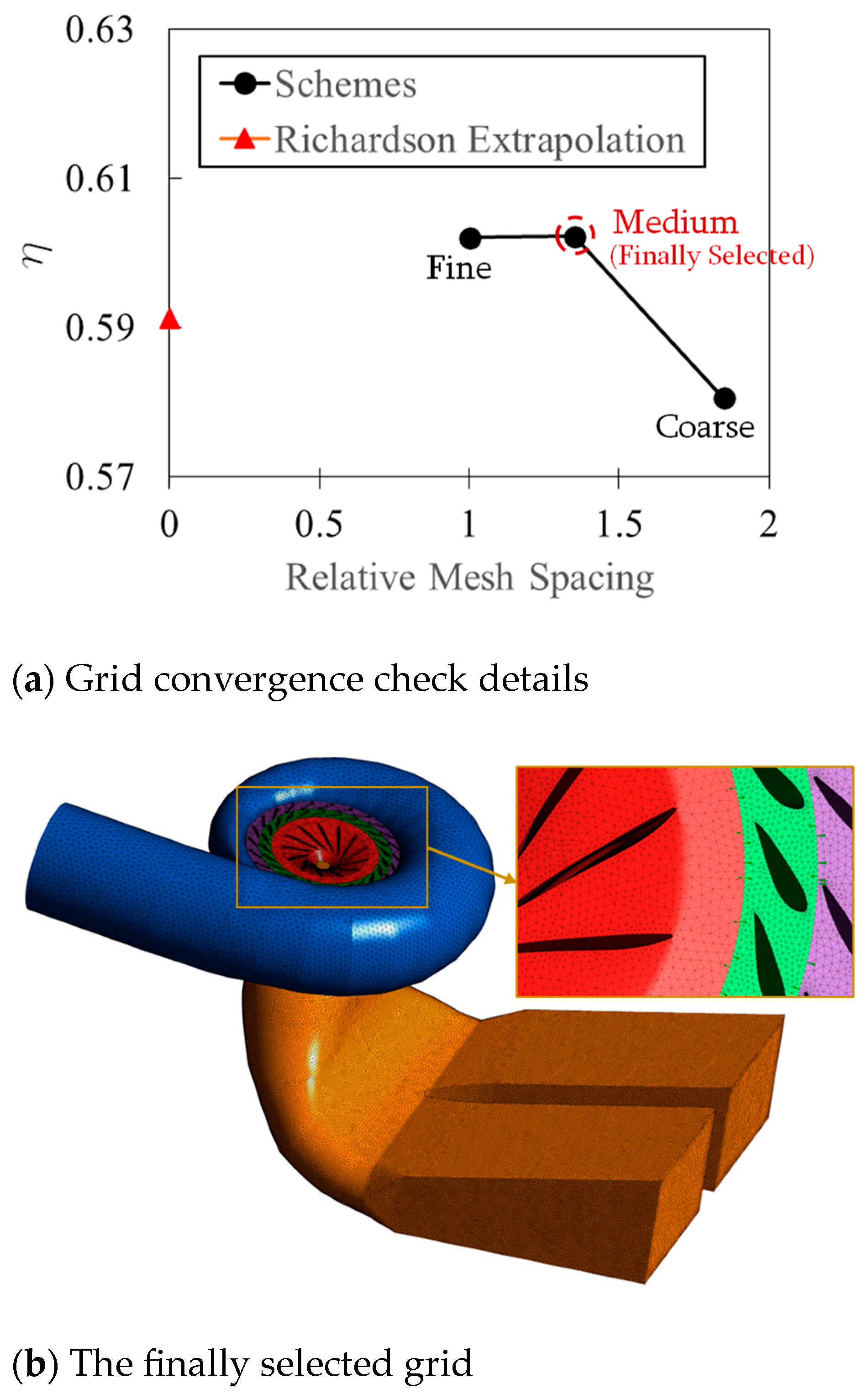

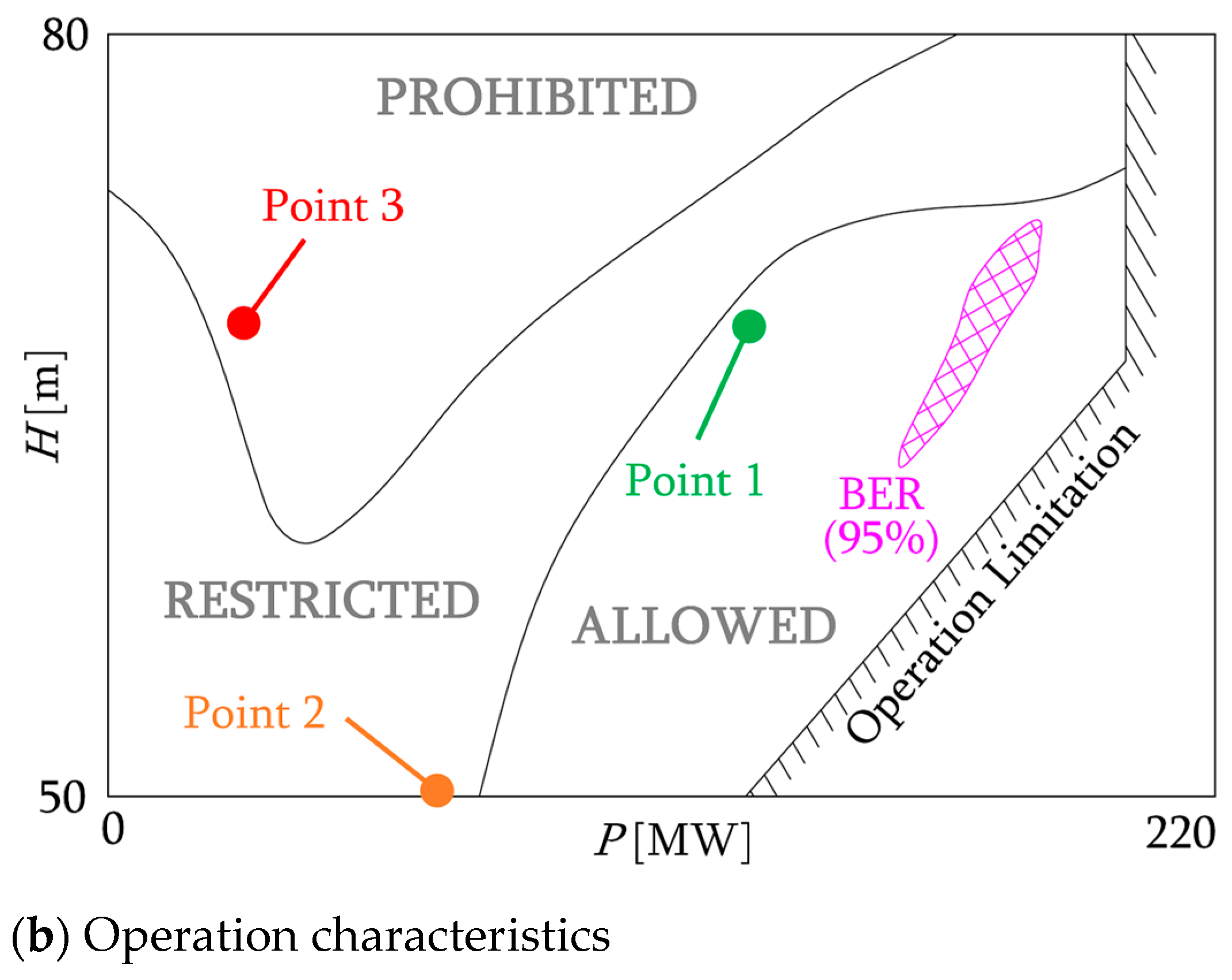

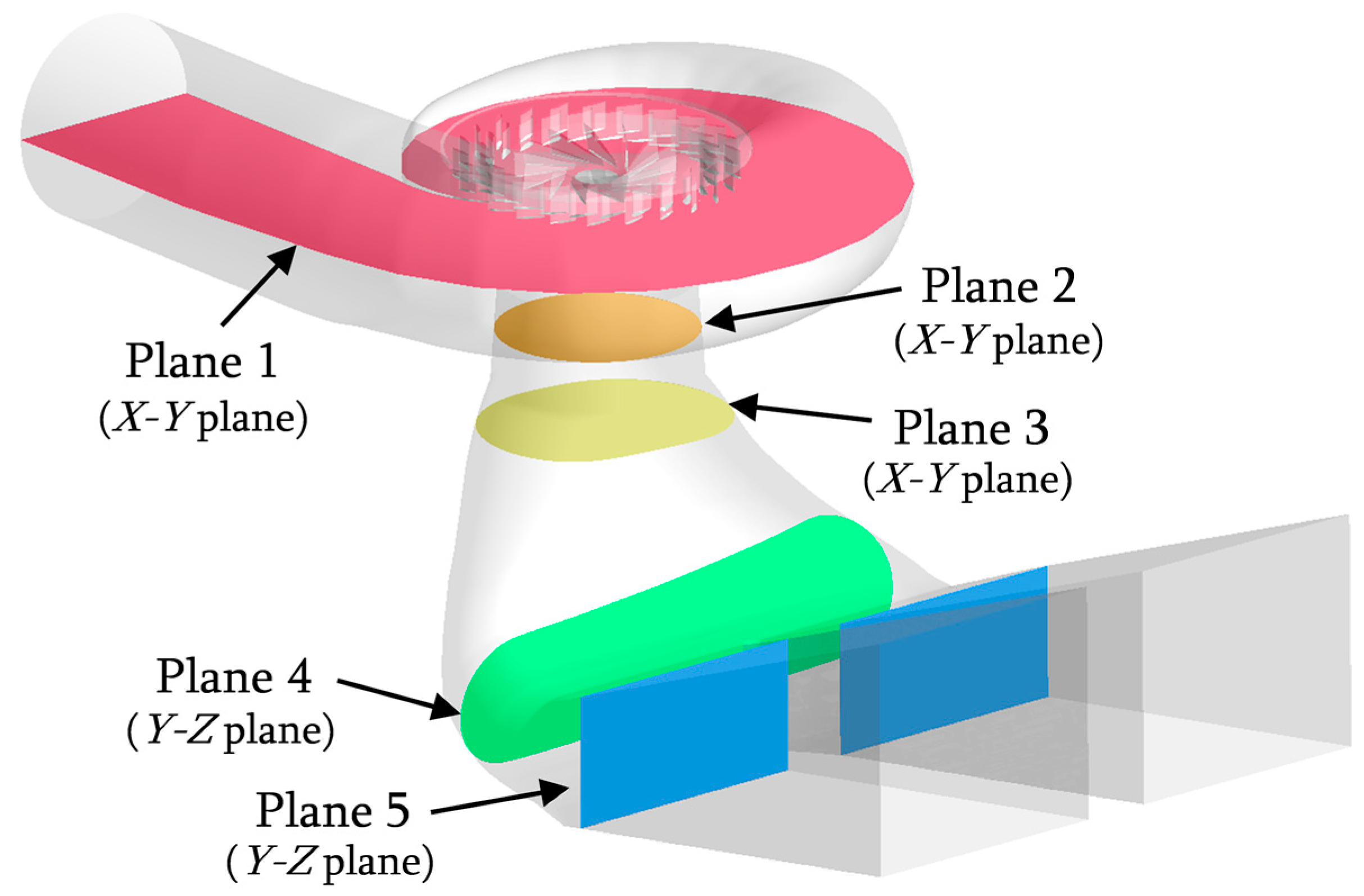

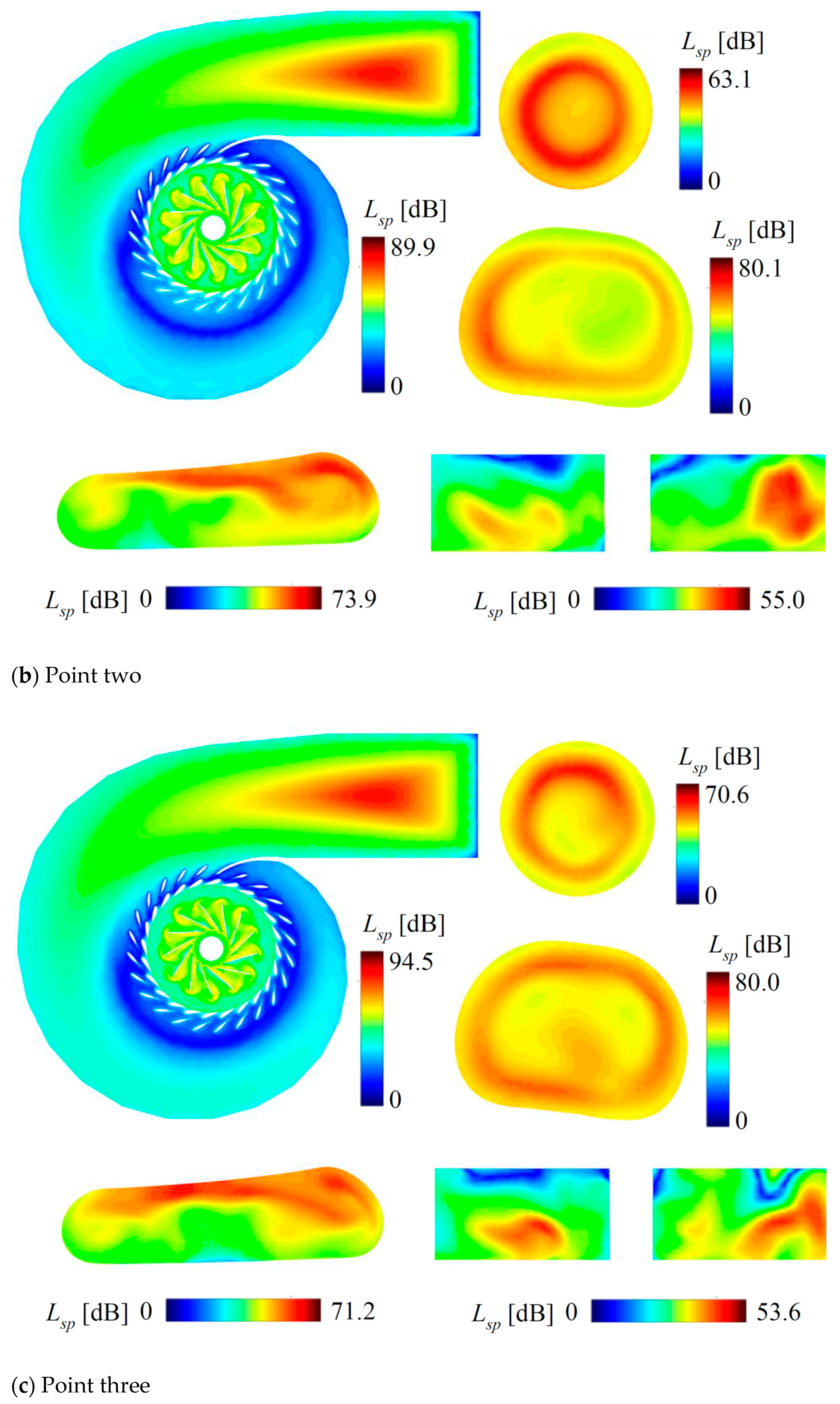

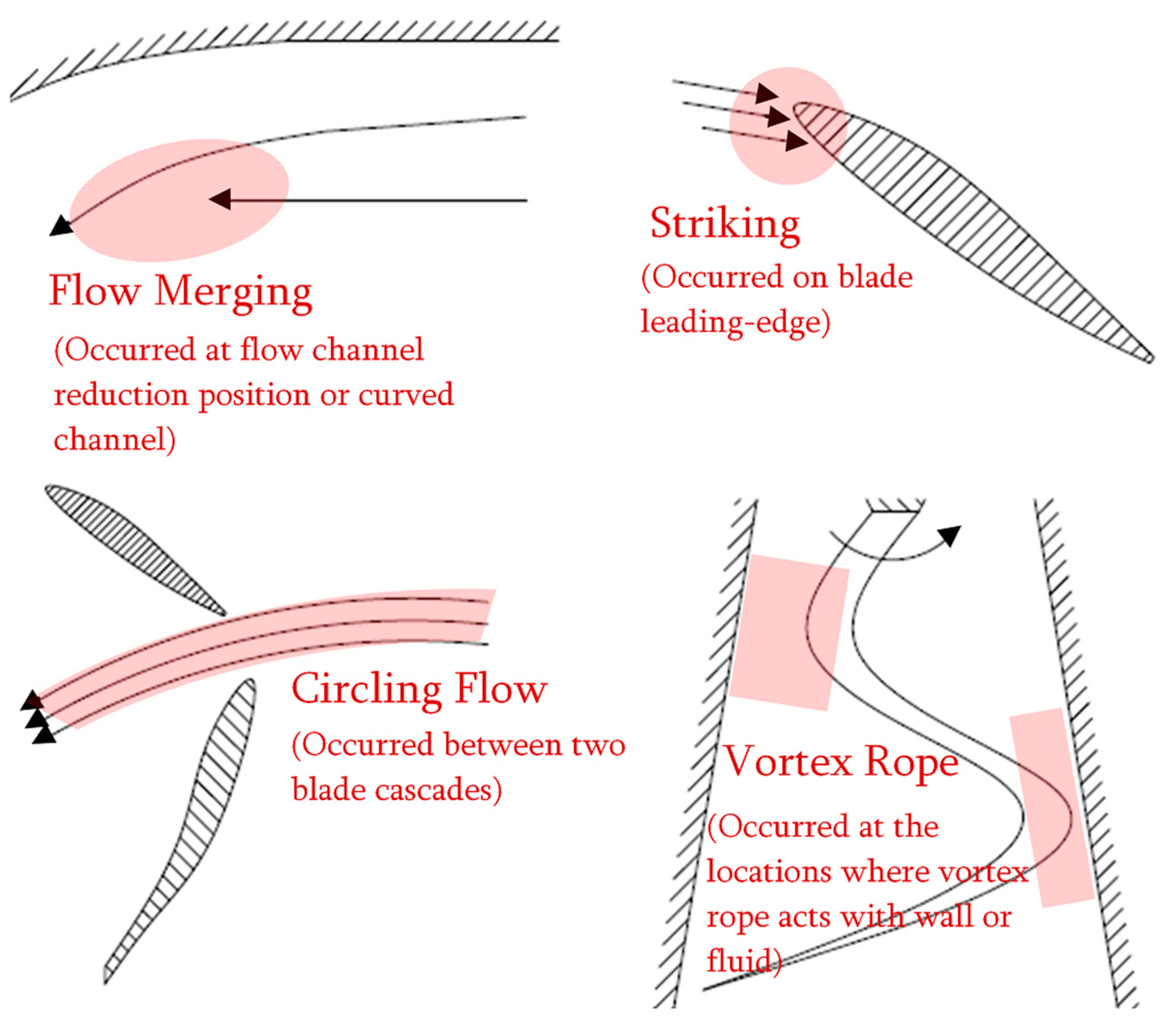
| Parameter | Value |
|---|---|
| Rotor diameter Drn | 5.80 m |
| Rated output power Pr | 183.7 MW |
| Rated flow rate Qr | 301 m3/s |
| Rated rotation speed nr | 100 r/min |
| Rated head Hr | 68.0 m |
| Maximum output power Pmax | 204.1 MW |
| Turbine installation height Hins | 895.00 m |
| Component | Grid Element Number |
|---|---|
| Spiral case | 209,260 |
| Stay vane | 558,230 |
| Guide vane | 623,824 |
| Runner | 897,680 |
| Draft tube | 464,692 |
| Total | 2,753,686 |
| Point | CFD Efficiency | Experimental Efficiency | n11 | Q11 |
|---|---|---|---|---|
| Point One | 91.05% | 90.51% | 77.85 | 0.7864 |
| Point Two | 71.72% | 70.32% | 78.55 | 0.3678 |
| Point Three | 55.25% | 52.88% | 91.21 | 0.3495 |
| Symbol of Position | Position Description |
|---|---|
| A | At spiral case inlet |
| B | Between stay vane and guide vane |
| C | In runner blade channels |
| D | Near runner cone in draft tube |
| E | Middle of draft tube straight section |
| F | Near draft tube elbow section |
| G | In draft tube diffusion section |
Disclaimer/Publisher’s Note: The statements, opinions and data contained in all publications are solely those of the individual author(s) and contributor(s) and not of MDPI and/or the editor(s). MDPI and/or the editor(s) disclaim responsibility for any injury to people or property resulting from any ideas, methods, instructions or products referred to in the content. |
© 2023 by the authors. Licensee MDPI, Basel, Switzerland. This article is an open access article distributed under the terms and conditions of the Creative Commons Attribution (CC BY) license (https://creativecommons.org/licenses/by/4.0/).
Share and Cite
Zhang, T.; He, G.; Guang, W.; Lu, J.; Song, X.; Zhu, D.; Wang, Z. Investigation of the Internal Flow in a Francis Turbine for Comparing the Flow Noise of Different Operation Conditions. Water 2023, 15, 3461. https://doi.org/10.3390/w15193461
Zhang T, He G, Guang W, Lu J, Song X, Zhu D, Wang Z. Investigation of the Internal Flow in a Francis Turbine for Comparing the Flow Noise of Different Operation Conditions. Water. 2023; 15(19):3461. https://doi.org/10.3390/w15193461
Chicago/Turabian StyleZhang, Tao, Gensheng He, Weilong Guang, Jiahao Lu, Xijie Song, Di Zhu, and Zhengwei Wang. 2023. "Investigation of the Internal Flow in a Francis Turbine for Comparing the Flow Noise of Different Operation Conditions" Water 15, no. 19: 3461. https://doi.org/10.3390/w15193461






